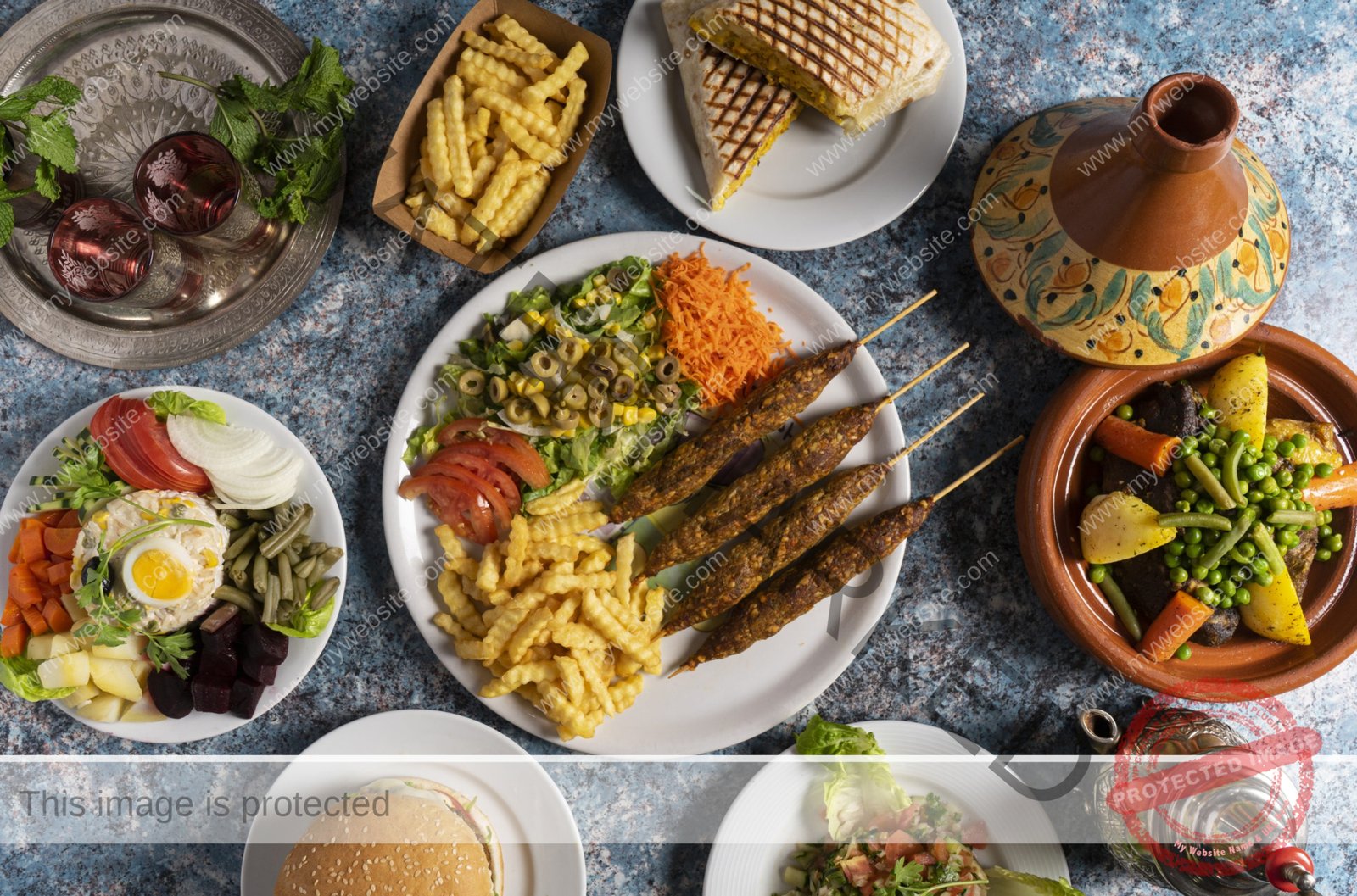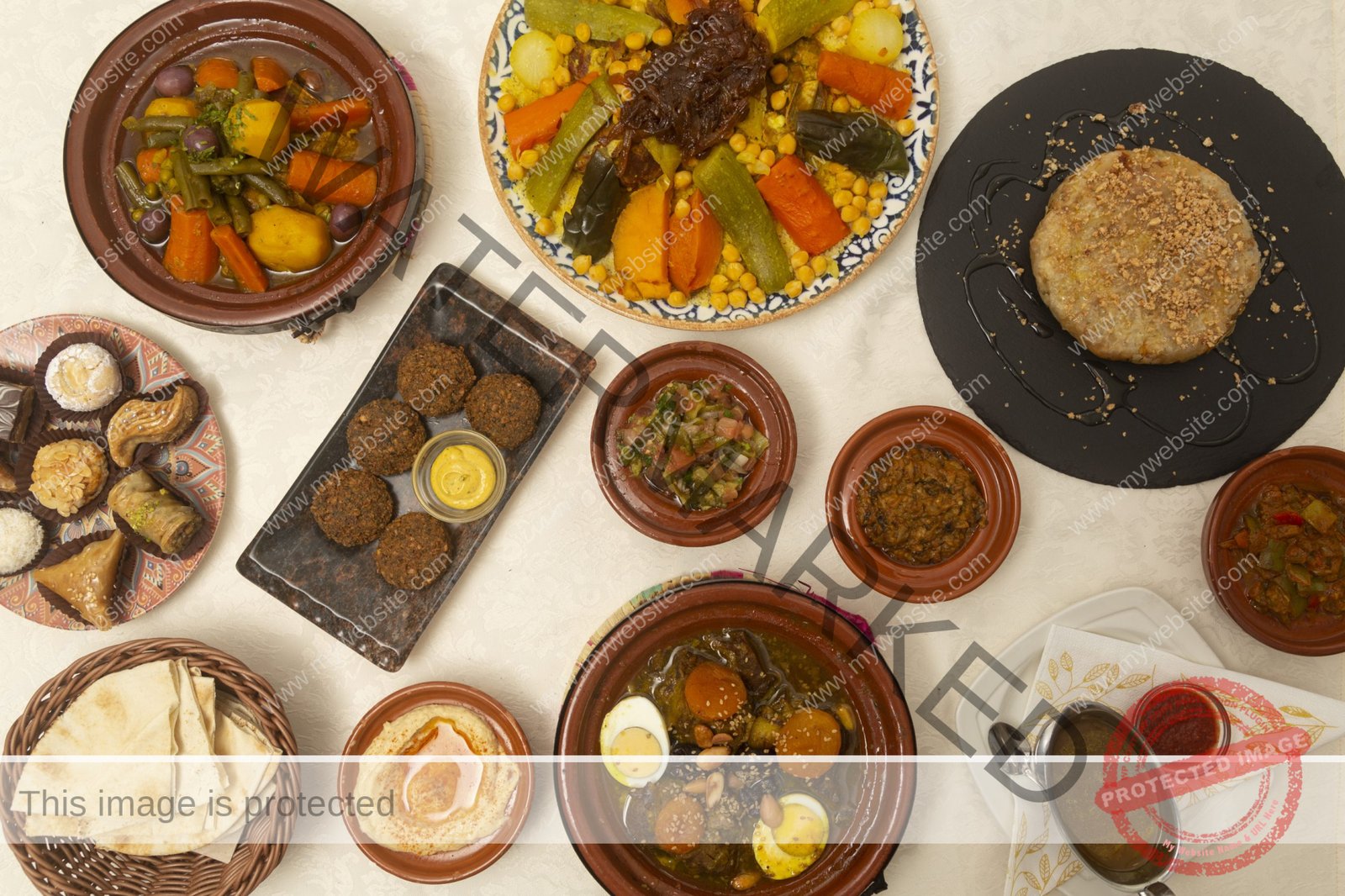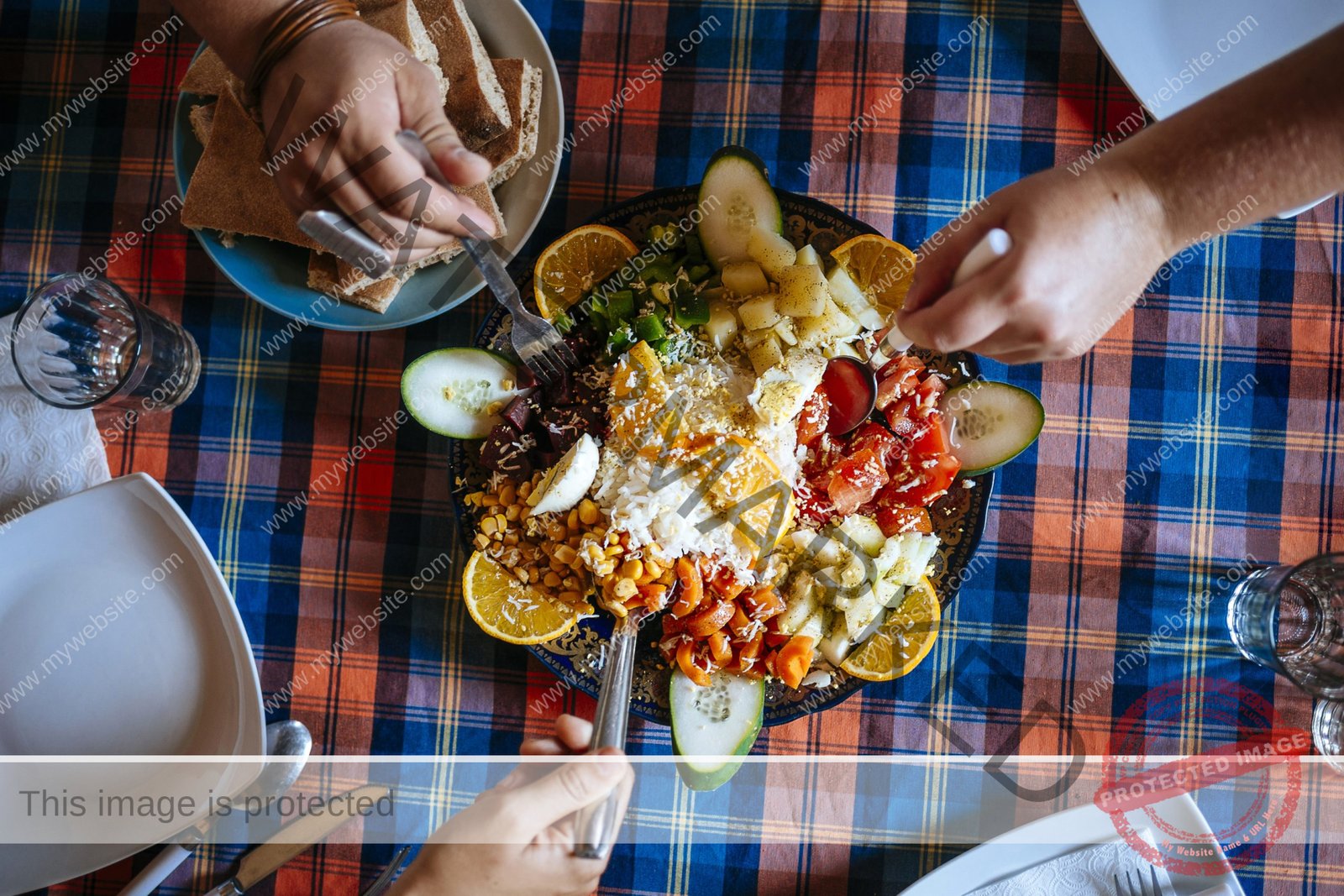Moroccan Cuisine means Fresh Moroccan food.
Moroccan Cuisine is known for its exceptional balance and health benefits. The Mediterranean region, where Morocco is located, has a diet rich in fresh vegetables, fruits, whole grains, and lean proteins, which form the basis of Moroccan food. This Cuisine is not only delicious but also highly nutritious, with a focus on using natural ingredients and spices that enhance the flavor of the dishes.
Research conducted by UNESCO has shown that the Mediterranean diet, a predominant part of Moroccan Cuisine, has significant health benefits and can help promote longevity. So, Moroccan Cuisine is worth trying out if you want to enjoy delicious and healthy food!
Moroccan Cuisine is a culinary delight that will leave a lasting impression on your senses. The Cuisine boasts a rich and diverse culinary heritage, incorporating various flavors and ingredients. Moroccan Cuisine is renowned for its delicacy and is considered among the best in the world. The Cuisine was ranked first in the Arab world and Africa and came second after France in 2012.
What makes Moroccan Cuisine unique is its blend of spices and herbs, creating a complex and flavorful flavor that is exotic and satisfying. The tastes of ingredients like saffron, cumin, paprika, ginger, and cinnamon lend a distinctive flavor to the dishes. The Cuisine also features a variety of meat and vegetable dishes, such as tagines, couscous, and harira soup, which are all cooked with a range of spices and herbs.
Moroccan food is not only delicious but also healthy, as it incorporates a lot of vegetables, legumes, and grains. The Cuisine is also known for its generous use of olive oil, a staple in the Mediterranean diet and considered one of the healthiest oils.
1. Moroccan Medeterian foods are the main component of Moroccan meals.
They consist of the following:
- Seasonings.
- Fresh ready food.
- All kinds of fruits.
- Veggies and whole grains.
Morocco is known for its rich cultural heritage, and its Cuisine is no exception. Regarding Moroccan food, two dishes stand out: Couscous and Tajin. These dishes are popular in Morocco and enjoyed by people worldwide. The secret behind their popularity lies in the unique blend of spices and flavors used in their preparation.
Couscous is a traditional Berber dish made with semolina, vegetables, and meat, while Tajin is a slow-cooked stew made with meat or fish, vegetables, and aromatic spices. Both dishes perfectly represent Cuisine and its fusion of flavors from Africa, Arabia, and the Mediterranean. Moroccan food is deeply ingrained in the country’s culture and traditions, and these dishes are a testament to the country’s rich culinary legacy.
Other types of food and dishes that are served in Morocco are:
- Fresh seafood.
- Hummus, Shish kebab.
- Moroccan mint tea, dates, and figs.
- Moroccan sweets and cakes.
- Moroccan mixed salad, Vegetarian food.
Geographically, Morocco is in a very strategic place. Thus, Moroccan Cuisine has been influenced by many different cultures for centuries.
2. Other cultures influenced Moroccan Cuisine
Moroccan Cuisine is a mixture of:
- The Middle East-type diet.
- Moroccan Amazigh and Arabs.
- The Mediterranean and Africa.
This is how some cultures have influenced Moroccan Cuisine:
- Arabs presented lamb and sugary foods.
- Jews added their marinated lemons and olives.
- Berber (Amazigh) communities introduced slow cooking over hot coal food.
Moroccan Cuisine is renowned for its rich and diverse flavors influenced by a blend of cultural backgrounds. The country’s Cuisine reflects its long and fascinating history, which has seen various civilizations come and go, each leaving a mark on the culture and Cuisine. This vibrant mix of cultural backgrounds has resulted in the creation of some of the most famous traditional Moroccan dishes that are enjoyed worldwide.
Moroccan food is a feast for the senses, with its aromatic spices, bold colors, and intricate patterns. Using ingredients such as saffron, cumin, cinnamon, and ginger provides a unique and unforgettable flavor profile that is both delicious and healthful. Moroccan Cuisine is a testament to the country’s rich culinary heritage and reflects its welcoming and hospitable culture.
Whenever Moroccan Cuisine is mentioned amongst tourists, it is mainly called couscous and tajine. Yet, Moroccan Cuisine is a lot more than just the two dishes. The types of dishes that exist in Morocco are endless.
3 Everyday Moroccan Dishes and Cuisine
These dishes share one desirable characteristic, which is mouth-watering flavors.
- Slow-cooked meats.
- I cooked vegetable salads.
- Fresh fruit types of juices.
- All kinds of homemade kind of bread.
- Flaky pastries with orange-flower water.
So many fast-food eating habits have been introduced to Moroccan culture.
Some of these fast food and snacks are:
- Tacos, pizza.
- Hot dogs, ice cream
- Chips, pitas, hamburgers.
- Fried Chicken, french fries.
- Onion rings, chicken nuggets.
In recent years, there has been an increase in the introduction of certain types of food that were not commonly consumed in Morocco before. This change in dietary habits is called a “diet shift.” It entails a shift from a traditional Mediterranean diet towards one that is sugar and fatty, such as fast food. However, it is essential to note that most Moroccans still do not consume fast food regularly. This shift towards a less healthy diet is primarily affecting the younger generation.
The rise in fast food chains and other Western-style food outlets contributes to this shift in dietary habits. Nonetheless, it is worth noting that traditional Moroccan Cuisine continues to be widely enjoyed and appreciated in Morocco.
4. Moroccan Cuisine and Vegetables.
Moroccan cuisine is renowned for its rich and diverse flavors deeply rooted in its culture and history. What sets this Cuisine apart is the use of fresh, locally grown ingredients carefully selected and prepared to create a perfect blend of spices, aromas, and textures. From the tender lamb tagine to the fragrant couscous, Moroccan Cuisine is a true celebration of the country’s abundant agricultural resources and the art of cooking.
Whether it’s the sweet and savory combination of honey and almonds or the pungent aroma of cumin and coriander, every dish in this Cuisine tells a story of the land and the people who have crafted it over centuries. So, if you want to experience the true essence of Moroccan Cuisine, indulge in the fresh, locally sourced ingredients that make it so unique and flavorful.
Most Moroccan food ingredients are cultivated by local farmers who do not use:
- Pesticides.
- Chemical fertilizers.
- GMOs (genetically modified organisms).
Most local farmers produce their food in smaller quantities and the old-fashioned way. Thus, you may not see organic certification and labels on the vegetables you purchase. Yet, this does not mean the food source from the average small-scale Moroccan farmer is not organic. The processing of labeling and the technologies involved are too pricey, which is an expansive investment for small farmers.
5. Moroccan Cuisine and Meat
Moroccan Cuisine is renowned for its delicious and unique taste, attributed to the country’s locally produced meat. Unlike many other countries, Morocco primarily consumes free-range and antibiotic-free meat, making their lamb, goat, and mutton exceptionally flavorful. The animals roam freely in open fields, scampering over mountains and valleys and subsisting on a diet of wild herbs and grass. This free-range lifestyle and herb-infused diet contribute to the animals’ distinct taste and quality. In addition to the meats above, some of the most common meat sources used in Moroccan Cuisine include beef, seafood, Chicken, and camel. Morocco’s variety of meat options allows for diverse flavors and dishes, making it a must-visit destination for food lovers.
6. Top 10 Moroccan Street food
Moroccan Cuisine is a diverse and rich culinary tradition that reflects the country’s history, geography, and cultural influences. Each region in Morocco has its unique way of cooking and preparing food, using local ingredients and spices specific to that area. From the seafood-rich dishes of coastal cities like Tangier and Essaouira to the hearty tagines of the Atlas Mountains and the spicy stews of the Sahara Desert, Moroccan Cuisine is a feast for the senses. Despite their differences, all these regional cuisines are authentic and represent the country’s culinary heritage.
Check out these top 10 Moroccan Street foods:
- Harira.
- Brochettes.
- Bessara Soup.
- Khobz (Bread).
- Msamen Merguez.
- Snails and snail soup.
- Steamed Sheep Heads.
- Chicken and beef Shawarma.
7. What you need to know and experience when visiting Morocco
Eating Food in Morocco.
Moroccans are well aware of cultural differences and are very understanding. Thus, they can accommodate visitors who prefer their way of eating. Yet, eating by hand all to everything together will surely give you a unique experience. This is an opportunity and experience that you would not have had a chance to experience otherwise in your daily life. Moroccans are very keen on keeping the hospitality level to the highest standard. Making the guests/tourist as comfortable as possible is their top priority.
Here are the eating habits that you may need to be aware of:
- In Moroccan culture, eating meals using your hands rather than silverware is customary. The process involves washing your hands thoroughly before eating, as it is essential to maintain good hygiene. Traditional Moroccan meals are often served as a communal dish; everyone eats from the same plate. To replace the use of a fork or spoon, Moroccans use bread to scoop up the food. This cultural practice is not only a way of eating but also a sign of respect for the food and the people you share it with. Eating with your hands is an integral part of Moroccan culture, and it is a unique experience that every visitor should try.
- Eating with the left hand is considered unclean. Yet, if you are left-handed, you only need to let the people you are visiting know. You will be fine because they want you to be comfortable.
- Morocco is expected to share a meal from a communal dish rather than serving individual plates. This tradition is particularly prevalent when eating dishes like Tajin and Couscous. However, it is worth noting that this does not mean that silverware is not used. Using utensils like spoons, forks, and knives while eating from a communal dish is acceptable. Ultimately, choosing how to eat and what utensils to use is a matter of personal preference and cultural norms.
- In Moroccan culture, there are certain expectations and etiquette when it comes to eating food. One of the most critical aspects is constantly using your right hand while eating. This is considered the correct and appropriate way of eating in Morocco. Additionally, you are expected to sit directly in front of your plate or bowl while eating. This demonstrates respect for the food and the act of eating. By following these customs, you can show your appreciation for Moroccan culture while enjoying the delicious Cuisine.
- To experience the authentic flavors of Morocco, it’s essential to immerse yourself in the local culture. One way to achieve this is by accepting an invitation to someone’s home. By doing so, you will have the opportunity to taste authentic Moroccan Cuisine and learn about the customs and traditions of the locals. This experience is not only delicious but also incredibly memorable. You will be able to cherish the memories of the warmth and hospitality of the Moroccan people for a lifetime. So, if you ever get the chance to accept an invitation to a local’s home, don’t hesitate. It’s an experience that you don’t want to miss out on.
- You are eating from part of the dish immediately before you would be best. Try not to extend across the opposite side of the spot in front of you. The above expectations are mostly applicable when eating couscous or tajines. These two main dishes are prepared so everyone gets some of everything from the served dish.
- Low carb. “Khobz,” which means bread, is the most frequently eaten together with most meals. Moroccans use bread for everything. They use it to eat tajines, salads, breakfast, snakes, and so much more. If you are gluten-free, you must be extra vigilant in what you eat in Morocco.
- Moroccans express their hospitality best by offering their guests the best dishpiece. Thus, don’t be surprised if they use their hands to give you a bit of meat or a favorite vegetable. It is an honor and signifies their hospitality.
- If you have any food allergies, it is essential to inform the people you visit and dine with about your condition. This will help them be aware of the foods they cannot consume and avoid any ingredients that may cause an allergic reaction. It is also advisable to carry any necessary medication with you in case of accidental exposure to the allergen. Remember, being open about your allergies can prevent unwanted symptoms and help you stay safe and healthy while enjoying meals with others.
In conclusion, Moroccan Cuisine is a culinary masterpiece that is loved by people all over the world. Its unique blend of flavors and ingredients make it a must-try for anyone visiting the country. From its savory tagines to its refreshing mint tea, Moroccan food will surely leave you wanting more.






